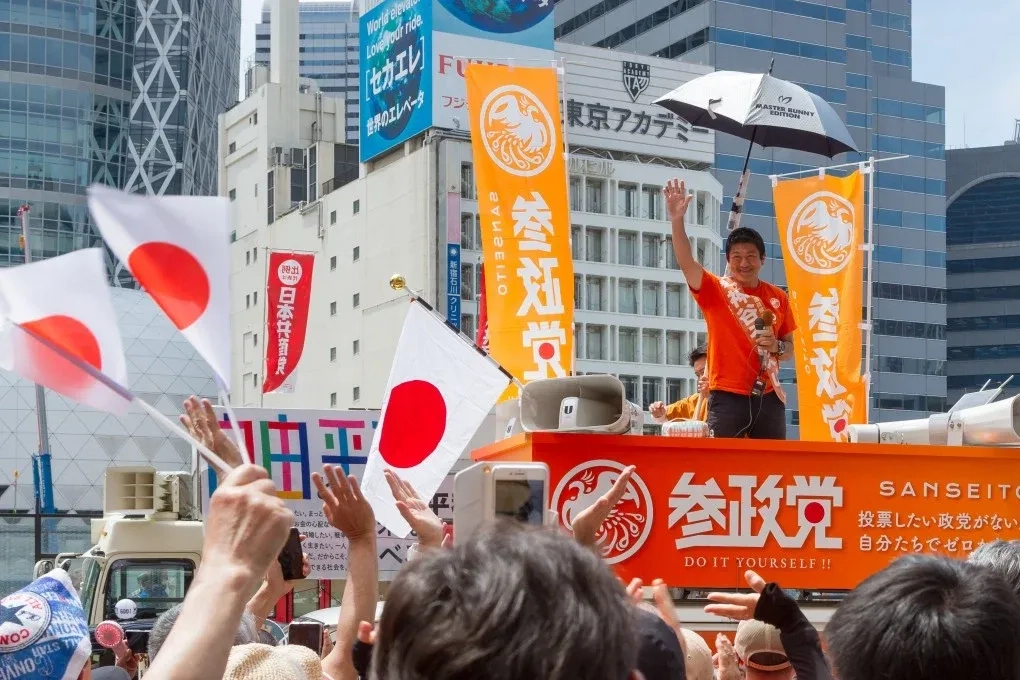We’re around 2 months past one of the more divisive elections in recent Japanese history, and although it’s still not entirely clear what the ramifications will be for the Japanese political establishment, something’s clearly up. Recent polling for the next general election has the usual frontrunner, the “no party” party, strongly out in the lead, followed by the even more predictable (and arguable more consequential) LDP [source:1]. But the fact that Japan’s now second-largest party is one that didn’t even exist five years ago, let alone one that has managed to beat out both the longstanding opposition CDP and DPP parties, suggests there are deeper tremors in the political landscape.
Since the comprehensive collapse of the Japanese Socialist Party in the 1960s, (and with it, the prospect of a genuine Japanese opposition) the ball has firmly been in the LDP’s court. And that's kind of where Japanese politics has lingered; Stuck in this liminal neoliberal space of being both firmly traditionalist yet uber-capitalist, even while the nation rapidly modernised, faltered, and later stagnated. The bursting of the bubble in 1989 seemed like it would finally be the moment where everything changed. But, as any chronically online zoomer will tell you, "nothing ever happens". Well, not in the Japanese political world anyway, scandals included.

You would think Japan’s strong nationalist streak and long history of isolationism would provide a fertile breeding ground for the kind of right-wing populism that has flourished elsewhere in the world. After all, extremely conservative, right leaning politics is Japan's bread and butter. Yet, Sanseito has always been a bit of an anomaly in that regard. Founded by Sohei Kamiya at the height of the pandemic in 2020, it began as a YouTube channel promoting COVID scepticism and distrust of mainstream medicine, before expanding into a broader, MAGA-esque critique of globalism and institutions [source:2]. Crucially, Sanseito is one of the few Japanese political parties to properly embrace social media, amassing grassroots appeal that no other party in Japan has ever really been able to achieve (Well, aside from the NHK Party, though it's probably best not to talk about them...[note:1]).
Sanseito’s rise has been boosted by its ability to mobilise demographics that have long been politically apathetic, with staggering efficiency. It has polled consistently strong with middle-class men in their late teens and twenties, a generation often described as being most adversely impacted by Japan’s lost decades. The party has promised to give a voice to the (willingly) silent majority, floating massive tax cuts [note:2] and wage increases, among other incentives to stimulate Japan’s long-idling economy [source:3]. Perhaps most alarming to Japan’s political establishment is how effectively they’ve managed to court the LDPs traditional rural stronghold. By emphasising self-sufficiency and pledging major investments in farming, the party has successfully stoked anxieties about globalisation and rural decay [source:4].
In a sense, Sanseito really isn’t too dissimilar to other populist movements across the world. But Japan has never really seen a populist right in this form. The party pledges to empower the downtrodden layperson against the big, scary establishment, using national pride and nostalgia to drive the point home. However, (and rather predictably), its ideology goes much further, wading into the global culture wars with a crusade against progressive values. It is hostile to equality, dismissive of LGBT rights, opposed to nuclear disarmament, and most peculiarly in the Japanese context, staunchly anti-immigration.
Now, I’m fully aware immigration has become an extremely touchy subject in modern discourse. Find me a comment section or a moderately sized family gathering where it hasn’t been brought up. But from my perspective, and perhaps that of many other foreigners who have lived or are currently living in Japan, it’s a bit more cut-and-dry. Japan has a staggeringly low rate of immigration. Recent statistics put the nation’s foreign-born population at around 3.7 million, or just 3% of the entire population [source:5]. By comparison, this figure hovers between 10% and 20% in most other highly developed nations [note:3]. For anyone in the know, it’s not hard to see why that figure is so low. Japan is a notoriously difficult country to move to, with visas, bureaucracy, and the absolute hassle of finding long-term accommodation. This is all on top of the latent discrimination and social exclusion that most foreigners are subjected to, even after living in the country for years.

It feels almost laughable that a country so averse to immigration can show such a lack of self-awareness around it. But, like any good conspiracy, there is a small kernel of truth beneath it all. Tourism, or more specifically over-tourism, has become a massive point of contention in contemporary Japan. And it’s not overly surprising to see why. A surge of pent-up demand after the pandemic, a historically cheap yen, and modest foreigner-exclusive perks like the JR Rail pass [note:4] and an abundance of tax-free shopping have made Japan a pretty sweet deal for foreign visitors. Tourists can effectively avail of all the benefits Japanese hospitality and culture have to offer, without having to give anything in return.
Seen through this lens, it’s plainly clear where Sanseito are coming from. They’ve successfully managed to tap into longstanding, pre-existing frustrations around foreigners and cash them in for substantial political gain. It’s not difficult to understand why the Japanese would get pissed off by the influx of loud, shouty foreigners clogging trains, harassing geisha, or committing cultural faux pas without facing the same of social consequences as locals. The LDP’s laissez-faire stance on most things immigration and tourist related hasn’t helped either. The strain increased tourism has placed on Japan’s infrastructure, along with the laundry list of high-profile, problematic IRL streamers, has not done much to help the average foreigner in Japan’s case.
Honestly, it’s not that it’s surprising a party like this would arise in Japan, rather that it took this long.
The sentiments that have fed Sanseito’s rapid growth are hardly Japan-exclusive (and certainly not unheard of in current year). Japan is just a microcosm of a broader, increasingly isolationist, populist mood taking shape across the globe. Closer to home, similarly lingering frustrations have begun to boil over. This past summer saw an eruption of anti-tourist protests across Southern Europe, with many locals rightfully pushing back against an all-consuming tourist industry that has gobbled up valuable public spaces and driven up housing costs in areas already under pressure [source:6]. While the European context differs somewhat from Japan’s, there’s a similar thread that runs through them both. Tourism, for all the developmental and economic benefits it brings, has started being seen as detrimental to the social and cultural fabric that makes these destinations desirable in the first place.
I genuinely think the increased accessibility and affordability of tourism has been a net positive in many ways. Speaking from personal experience, it’s allowed me to broaden my horizons and experience ways of living I otherwise never could, and I’m sure I’m not alone. Plus, who doesn’t love a cheeky weekend away to some medium-flung destination, only for Ryanair to dump you nearly as far from the city as the flight itself took? [note:5] But in a world that has become noticeably more closed-off in a very short space of time, weaponising locals’ (often justified) frustrations with tourists plays neatly into the narrative that movements like Sanseito thrive upon.

So, is this where we’re headed, back to the days of ethnically homogenous nations, all siloed off from each other in self-imposed bubbles? I mean, it’s not looking too great, right? I’ve heard people say quite a lot recently that politics moves in waves, with periods of rabid conservatism often followed by equally dramatic periods of revolution and openness. But is this really what the world needs right now? In an era dominated by challenges far bigger than any of us, such as economic volatility, the (increasingly) impending climate crisis, and almost certain population collapse in many countries, it seems like now is the time we need each other more than ever. The comfortable, relatively peaceful (albeit still imperfect) world many of us are lucky to live in was built on interconnectivity and cooperation. With the breakdown of communication we’ve recently begun to see across culture and politics (along with the devastating consequences it’s brought), retreating into isolation is ultimately a dead end.
Sanseito’s rise, and inevitable future successes, show us that even a nation long defined by order and consensus is not immune to the allure of populist grievance. What the consequences of that are still yet to be seen...
